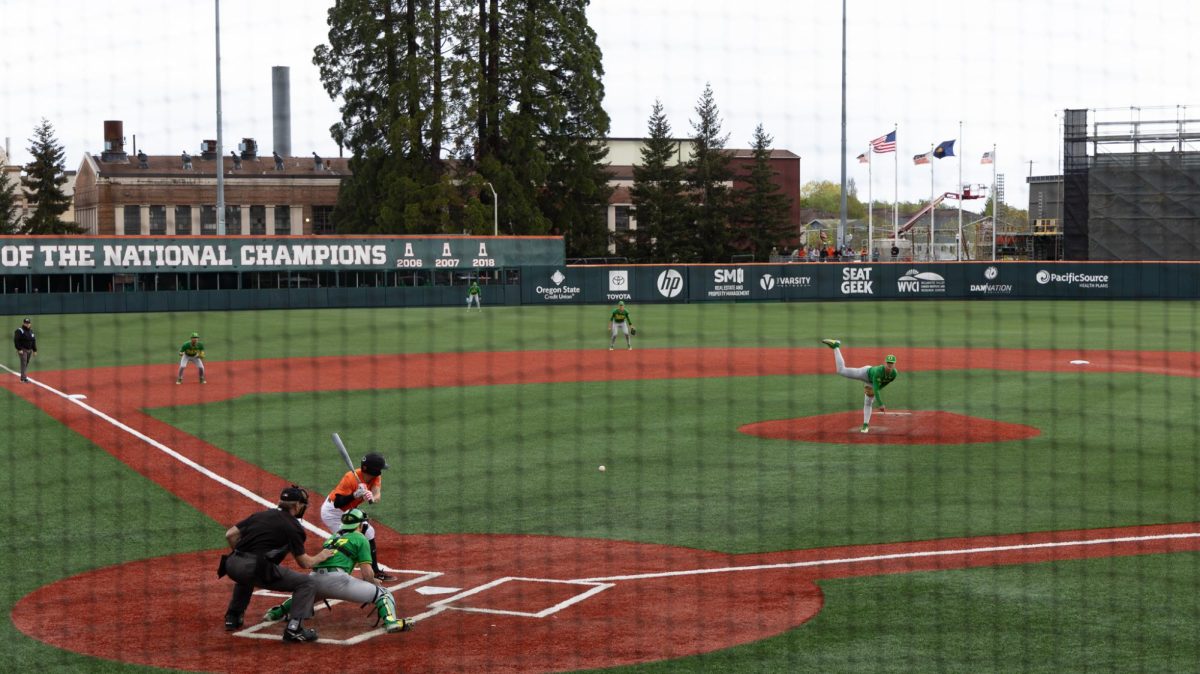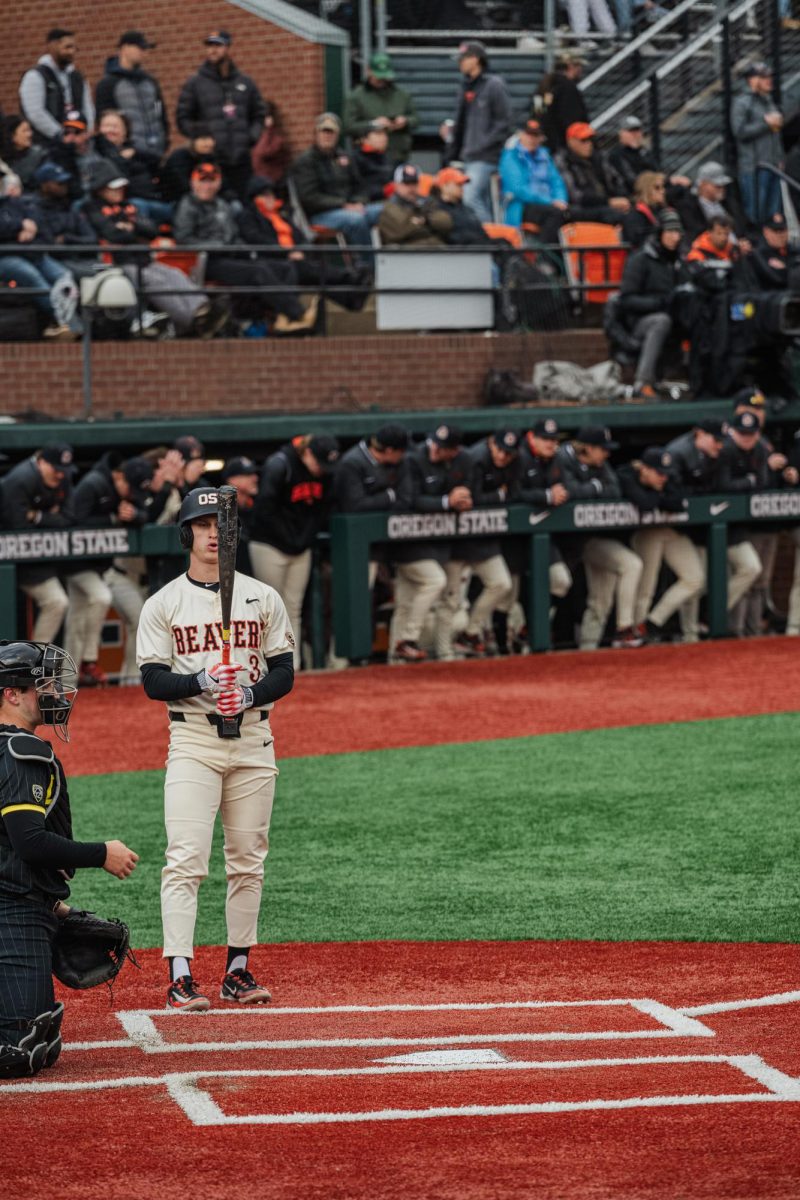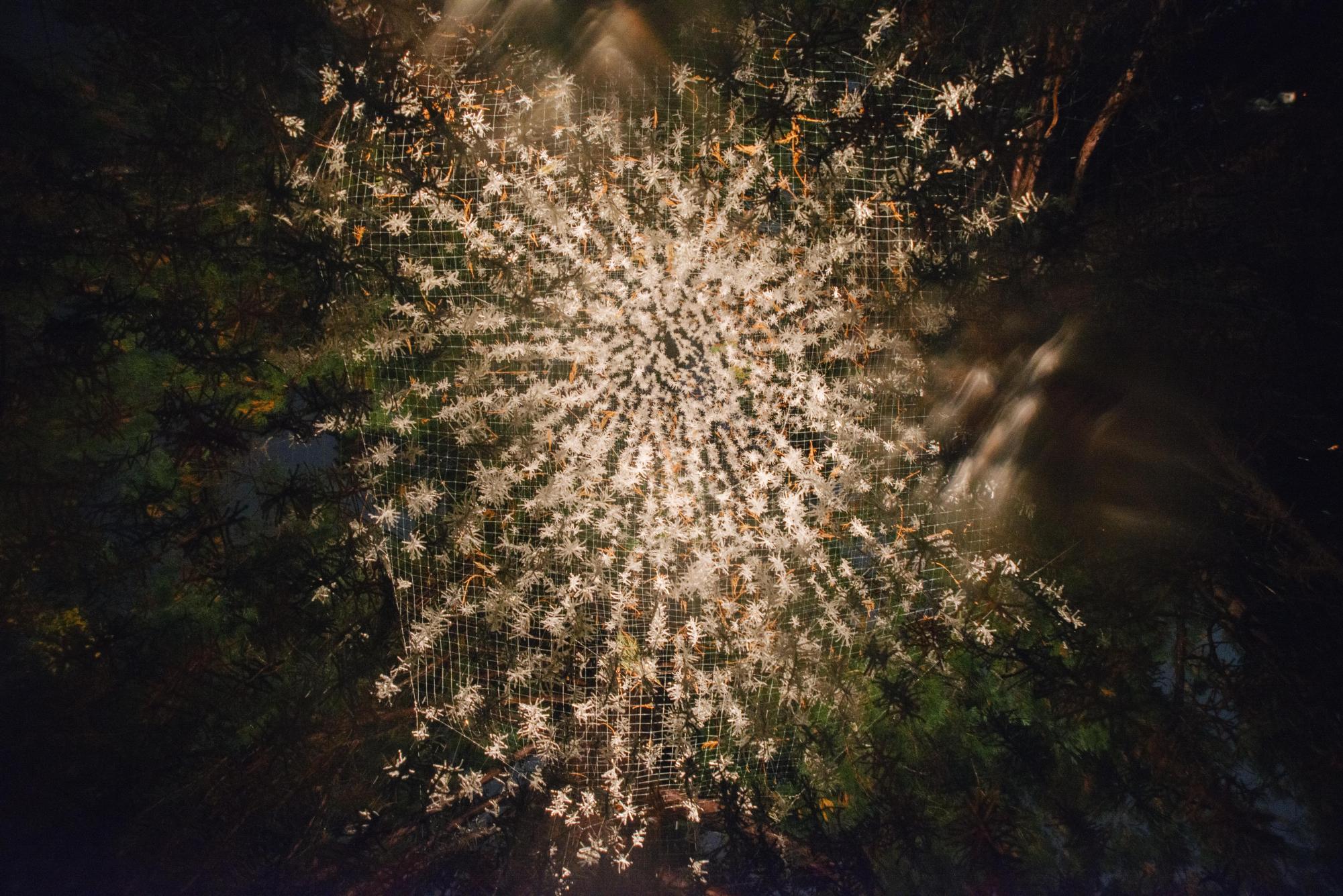A composite of ecosystem and art, the sequoia sculpture “Emeritus” has lived on Oregon State University’s campus for the last 14 months in the Memorial Union Quad.
This week, Emeritus has reached the end of its time and will find its new home on a remote island on Jan. 22 in Yukon-Charley Rivers National Preserve in Alaska, funded by the Anchorage Museum.
Emeritus was sculpted by Seattle-based artist John Grade, who has installations in the United Kingdom’s Kew Gardens, United States Embassy in Guatemala and the Smithsonian.
For his entire life, Grade has been fascinated by art. Born to parents in two worlds, one in poetry and one in science and research, Grade found his muse in the intersection of the two concepts.
“I love the creativity that’s inherent in science. And so I think there’s a lot to pull from, especially in collaborating with scientists,” Grade said. “I love the field work involved, the research involved, but then also putting these things into the landscape. There’s the sort of understanding of the scientific environment, and that’s really interesting to me.”
Though Grade selects his own installation sites, Peter Betjemann, executive director of arts and education at OSU, reached out to house one of Grade’s pieces as a prelude to the new on-campus performing arts center which highlights interdisciplinary studies.
“Of all the contemporary artists that I can think of, he is one of the most publicly and visibly oriented to forest conditions. And so that’s why we reached out to him,” Betjemann said.
While walking through campus for the first time, Grade came across a grove of three sequoia trees with a void the size of a fourth sequoia tree trunk.
“As soon as he saw the sequoia grove, he was like, ‘that’s it,’” Betjemann said.
To Grade, going into a landscape for the first time is about learning something new. Returning to the landscape to install a sculpture is about comparing landscapes and discovering how the piece and ecosystem interact with each other.
“We’re really thinking with that verticality of stressing this long, tall tree and is a single missing tree that’s going to be living somewhere else,” Grade said.
The piece was named “Emeritus” and built with assisted migration in mind, which is planting species that will thrive in future changing climates knowing that climate change is going to occur. This is done at the end of a species life to evade extinction.
Emeritus, which signifies a retired professor after a prolific career, represents the scholastic connotation that correlates the two ideas, according to Grade.
According to Betjemann, there is quite a lot of debate on the concept of assisted migration as it is an unnatural phenomenon.
“One of the concepts with this installation is that the artwork itself will migrate,” Betjemann said.
The pieces of Emeritus were designed with transitions from resin, to become translucent and reflect light during the night, then ultimately to Alaskan yellow cedar, some of which is burnt towards the bottom of the sculpture, to portray the adaptability of Sequoias to fire.
Though each piece resembles a tree form, the objective was to shape each element in a linear fashion to hold ice when it lives in Alaska.
“(Grade) welcomes the impact of environmental conditions on his work,” Betjemann said. “He has made works that melt in water, that are transformed, that mold, that sink, that disintegrate. All of the natural forces are his jam.”
Installing the sculpture included approximately 200 volunteer students, faculty and community members, many of which returned for multiple days, even participating in the hanging of the sculpture itself, which included a total of 10 fishing nets to hold the pieces in place.
Conner Mowery, a fourth-year psychology major was so inspired, he continued with Grade working on his following project.
“During the Emeritus installation I helped with volunteer coordination on the project, and generally aided the installation team with assembly and installation of the sculpture elements,” Mowery said. “I joined John and his team for the summer in their studio in Seattle. I primarily worked on fabrication of a sculpture that went up in Seattle this fall. It’s cool to see my work displayed in the final product on the install site.”
During its time at OSU, students have participated in classes under the dangling parts of resin and burnt cedar, writing and researching on the bases of both science and art.
However, students aren’t the only ones who’ve interacted with Emeritus.
Using artificial intelligence, the installation identified bird sounds in the sequoias throughout the seasons. With the bioacoustic recording devices, it wasn’t just bird sounds that were detected but also bats.
This system of tracking the biodiversity in the area allowed researchers to understand the species that frequented the area not typically visible to humans.
Along with the bioacoustic recording, the structure collected environmental DNA from the various species that rainwater touched on its way through the sequoia canopy.
The OSU College of Forestry collected the eDNA to create an inventory of species and look for new ones.
“We all know that nature is never static, it’s always changing. This installation changed over the 18 months, and while its time here is now finished, its representation is of regeneration as it takes on its new life and its new chapter in the ‘drunken forest’ in Alaska,” said Tom DeLuca, the college of forestry dean at OSU.
The installation not only tracked the species that frequented the grove, but also tracked the movement of the trees. The dendrometers placed by the OSU College of Forestry allowed them to track the trunk diameters and changes in the trees themselves.
“Directly or indirectly artists encourage creativity in scientists, and importantly artists can also help scientists reach broader audiences and make emotional connections that encourage learning and engagement about issues facing our world,” DeLuca said.
The artwork itself will be migrating north to a remote island in Alaska, where, according to Betjemann, temperatures can reach -40 degrees Fahrenheit.
Emeritus will be transported by truck and trailer to Grade’s studio in Seattle. After that, the pieces will be placed on a barge in crates to Alaska, moved by snow machine and finally walked to its final location.
Right now, Grade’s team is running tests to figure out how to assemble it with double knitted hands since the temperature is too harsh to remove gloves. With only three hours of daylight, they will have to use headlamps to finish installation in the dark.
The piece will be installed in a horizontal configuration compared to its vertical shape at OSU in a drunken forest, which is a description used when permafrost has melted–a comment on climate change–and trees begin to fall relative to one another.
Emeritus will remain in Alaska for about one week, out of respect to the Indigenous lands it will reside on. John Hagen, a Haines based Aleut and Inupiaq photographer, will document Emeritus as it lives in Alaska.
“In Oregon, there was that beautiful void between the trees that I wanted to give expression to. And then in Alaska, these are little spruce trees, they’re not much more than 30 feet tall,” Grade said.
As Emeritus begins to accumulate ice, it will start to bend and sag and take a new shape.
Grade hopes that the OSU community will continue to make memories through the media captured of the sculpture while in Alaska.
While it was at OSU, a student, Elijah Zeigler, felt that Emeritus was a reflection of the welcoming atmosphere on campus.
“Emeritus is special not because it fulfilled one artist’s vision but because it made connections between communities of people that possibly never existed before. Everyone will interpret this sculpture differently, I see it as a symbol of social connection and a celebration of life,” wrote Zeigler in a message read at the Emeritus farewell last week.
Betjemann’s hope is that OSU continues to stay engaged with the piece even after it leaves.
“My wife who works on campus was walking around a few weeks ago and she was walking by (Emeritus) – and this is very loving to me – she was walking behind a couple of students and everyone passed by Emeritus and one of the students said to the other ‘you know, I’m gonna really miss that when it’s gone,’” Betjemann said. “That makes the project worth it.”
Mark Fitzharris contributed to this story in a project for OSU’s AJ 313 Media Storytelling.














































































































